Click here for a downloadable pdf copy of this page.
Study 1
 |
| Output doubled plant-wide |
The bottom line in this example is that output doubled in this medium-sized manufacturing plant as the result of introducing pallet lifts and related layout changes throughout the operation. Simultaneously, the risk of back injury was also reduced dramatically. Before-and-after details from one of the lifting tasks are shown below.
 |
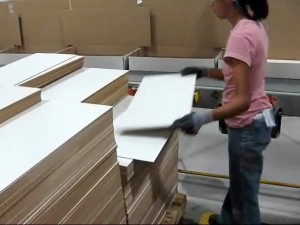 |
| Before: Lifting, carrying, walking, and packing | After: Packing |
The task in this first example is a packing job. Before improvements were made, the task involved bending to lift products from a pallet on the floor along with other wasted steps. The improvements involved using pallet lifts plus changing the layout, which eliminated the bending and other wasted steps. Afterwards, the task was simply to pack.
The graphs below show the results from the Time and Physical Demands Analysis of a single cycle of packing three products, both before and after the use of pallet lifts. The “before” graph shows the steps of the job and the strain on the back and time involved for each step. The “after” graph shows the equivalent once the pallet lifts were installed and the wasted steps eliminated.
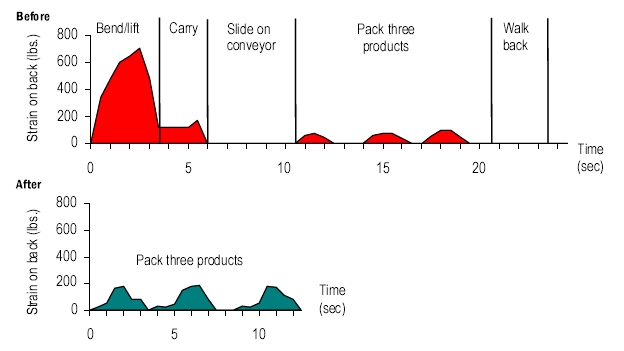
The visual display of the graphs clearly shows both: (a) the high strain on the back and the time associated with bending and lifting, and (b) the reduction in both time and loads on the back that resulted from use of the pallet lifts. Note that the steps of carrying, sliding on the conveyor, and walking back do not involve back strain, but are unnecessary.
Results of quantitative analysis:

Notes on units of measurement:
- Technically, the load on the back is the compression force on the discs in the lower back, reported in pounds.
- The time-weighted loads are the estimated areas under the curve. These loads provide the best measure of total strain, but are meaningful only in comparisons within the same task, thus units are eliminated.
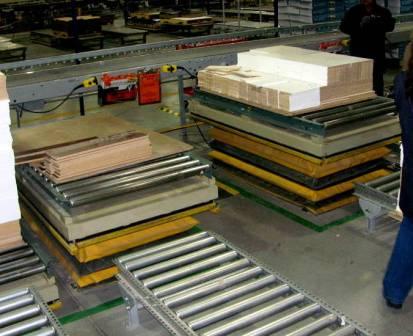
Improvement: Standard powered hydraulic pallet lifts, with conveyor spurs for staging incoming pallets
Study 2
 |
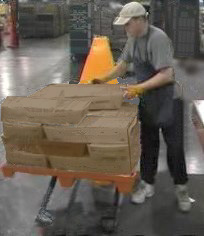 |
| Before: Bending | After: No wasteful bending |
This is a similar example from a distribution center showing how a pallet lift reduced cycle time for a simple lifting job by 14 – 20%, plus reduced the load on the spine by 66%.
The graph below compares lifting a series of eight boxes, first with the pallet on the floor and then with the pallet lift. The results are superimposed to help highlight the differences. Each peak represents one lift. The lower the peak and the less area under the curve, the less strain on the back. The less horizontal distance at the base of each peak, the less time needed to make the lift.
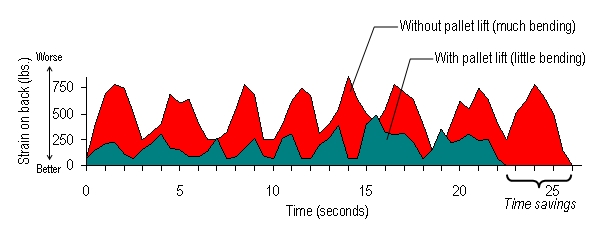
Once again, the visual display of the graph clearly shows the benefits of the pallet lift and raising the boxes off the floor:
- The peaks are lower, indicating less risk of injury
- The area of the graph is less, also indicating less risk of injury
- The time to perform the task is less, specifically eight trays are lifted using the pallet lift in the time it normally takes to lift seven.
Quantitative results are:

Cost-benefit evaluation
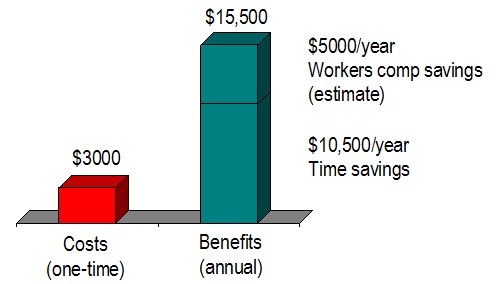
The type of pallet lift used in this instance was the lifter-transporter shown below, with a cost of about $3000 at the time. Given the wage scale and volume of lifting for this job, the time savings was $10,500 per year. Cost avoidance for injuries is difficult to calculate, but for this job it was reasonable to estimate roughly $5000 per year.
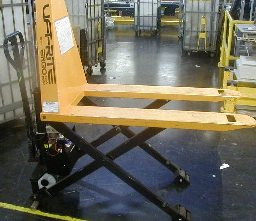
Improvement: Lifter-transporter — a combination pallet jack and powered scissors lift
